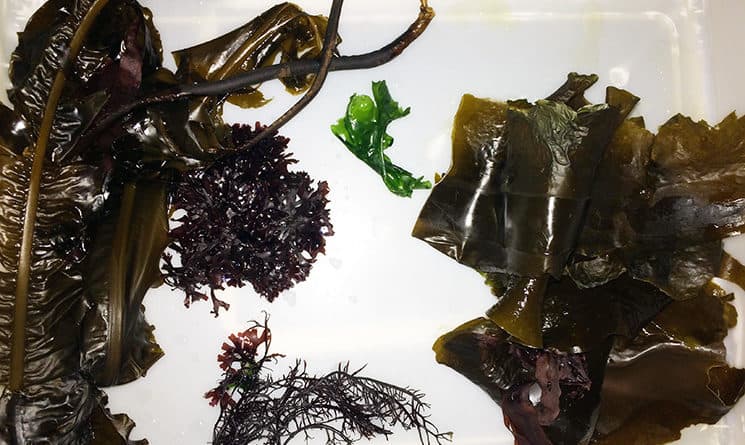Seacoast researchers and chefs are teaming up to put kelp on local plates
By Charlie Weinmann, photo by Gabriela Bradt
How you feel about kelp depends on where you find it. You might shiver as it grazes your toes while swimming in the ocean. If it appears on your plate in a gourmet restaurant, you might be surprised, or even a little worried about how seaweed got into your favorite dish. Don’t be alarmed, though: Kelp is tasty and healthy. And, thanks to a recent collaboration between the University of New Hampshire and Seacoast chefs, kelp could be the next food trend (sorry, kale).
Chef Evan Hennessy of Stages at One Washington in Dover has been using the seaweed as a staple ingredient in many of his dishes for about a year. He recently teamed up with local fisheries and aquaculture specialists from the university’s Sea Grant and Cooperative Extension for two workshops on the seaweed’s many uses.
According to the Cooperative Extension’s Dr. Gabriela Bradt, kelp is versatile and extremely healthy.
“Kelp (and other sea vegetables) are incredibly full of both macro and micronutrients. Kelps in particular are rich in iodine, calcium, potassium and magnesium, and other vitamins. Kelps also have glutamic acid, which is an amino acid, which is a natural tenderizer for other foods (such as legumes) and helps with digestion,” she said.
“It is thought that kelps are good for pulling toxins out of the body.” — Dr. Gabriela Bradt
of the UNH Cooperative Extension
And, when it comes to filtration, kelp is a superstar, according to Bradt. UNH’s aquaculture program has been using sugar kelp and mussels to help filter nitrogen in the Piscataqua River for the last year. That kelp has been harvested and some has been sold to local restaurants. Once diners eat the kelp, it keeps on filtering, Bradt said.
“Because kelps also have alginic acid, which is a sugar found in the cell walls of the plant, it is thought that kelps are good for pulling toxins out of the body,” she said.
Hennessy started experimenting with kelp about a year ago. He’s dehydrated it, fried it, and used it as a thickening agent.
It’s “more nutritious than kale could ever want to be,” he said. “Not only does it give the dish meaning, but it gives it that anchor of flavor back to the ocean.”
At Stages, Hennessy often makes dashi, a Japanese seaweed broth made with dried harvested kelp. He also uses kelp to create different sauces and broths.
Chef Evan Hennessy (right) of Stages at One Washington often uses kelp as an ingredient. Photo courtesy of Rebecca Zeiber, NH Sea Grant.
Hennessy had previously worked with Bradt through the New Hampshire Community Seafood program. He wanted to use Stages as a kind of lab for researching and developing seaweed as a food source. The workshops attracted everyone from aquaculture and agriculture researchers and specialists to home cooks and oyster and trout farmers.
“It was really this star-studded cast of people from in and around the food and aquaculture industry,” Hennessy said. “We very much look at cooks and restaurants as the conduit between researchers and the public.”
Kelp has been a part of Asian cuisine for centuries, but its popularity in the United States is a recent development.
“I think people are starting to realize that sea vegetables and seaweed are not just necessarily restricted to sushi anymore,” Bradt said. “Sea vegetables are not only jam-packed with nutrients and flavor, but they are so versatile.”
How versatile? Chef Evan Mallett of Portsmouth’s Black Trumpet Bistro started using kelp in salads three years ago. And then he found another use for it.
“I decided that, because of its shape, it would make a really good wrapper,” Mallett said. Now, steamed lobster wrapped in sugar kelp leaf is one of his most popular dishes.
“If we as restaurants can utilize it, it gives diversity to foods on our menu, and the home cook can incorporate it too.”
— Chef Evan Hennessy
While many diners have embraced kelp, Hennessy is working on making it palatable for a tougher audience: kids. Hennessy has convinced his three children to try smoothies made with yogurt, mixed berries, and seaweed
“You have a little bit of a salty thing, which kids like, but it’s not like, ‘Oh, that tastes like the ocean,’ or, ‘that tastes like seaweed,’” Hennessy said.
Even if kelp doesn’t catch on with younger audiences, it’s popular, versatile, and healthy enough to remain in the spotlight, and on plates, for a while.
“It’s the fastest growing plant in the ocean and so it’s there for us to use, and it has many uses,” Hennessy said. “If we as restaurants can utilize it, it gives diversity to foods on our menu, and the home cook can incorporate it too.”

